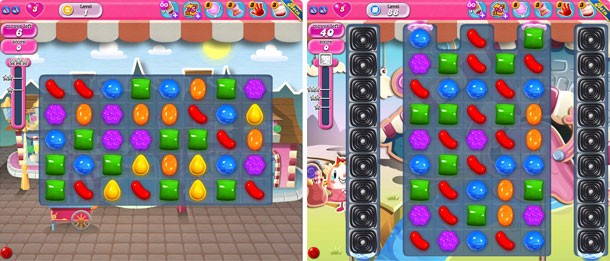Candy Crush Is As Devious As It Is Delicious

Back in 2013 when King.com's Candy Crush was a small game with a lowly 10 million daily users, we chatted with King's Tommy Palm about how the game began and how it has become such a phenomenon. In light of Activision's $5.9 billion purchase of King, we decided it was a good excuse to reshare this brief interview. This article originally published on February, 14, 2013.
Candy Crush Saga may be the biggest game you've never heard of. The color-matching game has attracted a few fans since it launched on Facebook in April 2012. OK, that's a bit of an understatement. Since Candy Crush Saga was released, it's attracted nearly 10 million daily users, putting it at the top of the Facebook charts. King.com has also released a mobile version of the game, and progress between both platforms is shared. We spoke with King's Game Guru Tommy Palm about Candy Crush and the company in general, just in time for Valentine's Day.
Candy Crush Saga is a diabolical game that starts off like a simple color-matching game, but it quickly escalates into one of the most difficult puzzle games I've played. As you play, you move your icon around on a Candy Land-inspired board. By the time you hit that gradual difficulty curve, you're hooked. And that's the point. To provide some reference, the picture at top left is the first level, and the one on the right is level 88. If you play long enough to see it, you'll learn to loathe licorice. Levels have their own gimmicks, too; it's not a simple matter of matching colors and calling it a day. Sometimes you have to clear jelly off the playspace. Other challenges require you to hit a goal score before the timer runs out. And there are deeper mechanics at play, such as warp spots, special candy combos, and chocolate bars, which spread like a disease.
The candy-coated appearance makes it all the more frustrating. There's an element of insult to injury at play, when you're butting up against jelly beans and hard candy, and you only have a few turns remaining.
Like many of King's games, Candy Crush Saga first appeared on King.com. The site was founded in 2003, and it now features more than 150 original games. Palm says the site is used as a test bed for games, where user feedback is incorporated and games are iterated upon. That's how Candy Crush Saga came about. The "Saga" suffix is a relatively new term, which the company uses to denote games that feature progress over time, rather than the one-off experiences that most puzzle games provide. So far, there are eight games in the Saga series, including Candy Crush, Pet Rescue, Bubble Witch, Pyramid Solitaire, Mahjong, Bubble, Hoop de Loop, and Puzzle. Bubble Witch was the first in the series, attracting six million daily players at its peak.
Like a lot of Facebook and mobile developers, team sizes at King.com are small. For instance, Candy Crush Saga was created by a team of fewer than 10 people (the mobile version's team was about eight). And that game draws in about 9.7 million users a day.
Palm says that one of the key reasons behind its success is simple: targeting the right people. "The main target group that we’ve focused on is women between 25 and 55," he says. "And it turns out that if it works really well for that target area, it works pretty well for everyone."
Microtransactions are an inevitability in Facebook gaming, but King seems to have hit a relative sweet spot (sorry for the pun). "The large number of people are playing games for free, and they should definitely continue playing the game for free," Palm says. "They are still valuable to us, so we want to keep them in here and we want them to have a great experience." One of the advantages that Facebook devs have at their disposal is the ability to efficiently track players. "[If] people are stuck somewhere and there is some frustration, we can iron that out and update the game quickly, and make sure that the challenges should still have to be there, but they have to be balanced," he says. When players run out of turns, they can either choose to pay for additional turns, ask friends for more, or merely wait for the clock to recharge. There are also persistent power-ups that, when purchased, are available forever.
I spend a fair amount of time at night playing the game on my iPad. As it turns out, I'm not alone there, either. Palm says his team has found that most of the Facebook players are doing so during the day, while mobile players are sliding candy around on weekends.
I asked Palm what his favorite level is, and he didn't hesitate in his answer. "My favorite level is level 55," he says. "I play that over and over again like crazy, even though I’ve progressed way over there, but for some reason I go back and play level 55. It’s a really really cool level. You only have 15 moves. It’s like a self-playing piano. Sometimes you can just get the bonuses to trigger each other, time again. I really recommend it, try level 55." He says his high score on that one is 2.2 million, and that he's played it 400-500 times. I suppose you get to do that when you're the Game Guru.
If you'd like to check it out for yourself (and you should), you can do so on Facebook or via the iOS or Android app.

Get the Game Informer Print Edition!
Explore your favorite games in premium print format, delivered to your door.
- 10 issues per year
- Only $4.80 per issue
- Full digital magazine archive access
- Since 1991









